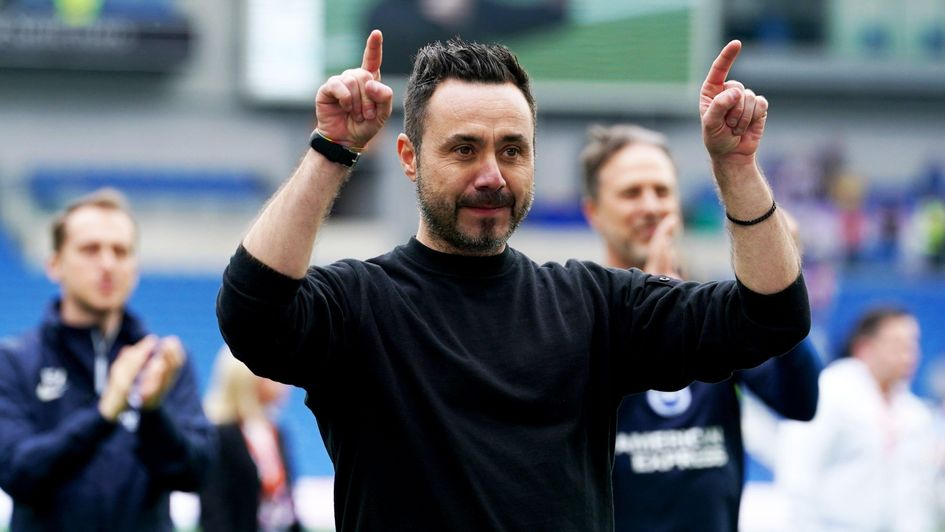At the time of writing, two of the world’s most coveted managerial jobs will be vacant in the summer: Liverpool and Barcelona.
- Dharnish Iqbal (@DharnishIqbal) is a football writer who specialises in Premier League tactics as well as all things European football.
It’s interesting that both Jurgen Klopp and Xavi spoke of exhaustion, pressure and running out of energy while in the positions everyone else in their line of work would dream of being in.
The top jobs are highly rewarding but come with intense scrutiny and long hours few can handle.
The elite manager market is currently scant.
Bar Hansi Flick and Antonio Conte, there is no obvious name, with previous managerial experience at an elite club, whose signature both teams will be vying for - and even those two come with their frailties.
So, who instead? Well, the manager that has been hotly-tipped as the next best thing in elite football is Italian Roberto de Zerbi, who has lit the Premier League up at Brighton.
Arrigo Sacchi recently wrote in Gazzetta dello Sport about how glad he was the ‘most exciting coach of the last generation’ was ready to sit on an ‘important’ bench.
In April 2023 before Manchester City faced Brighton, Pep Guardiola said De Zerbi’s side ‘have the best build-up in the world’.
But what is it exactly that De Zerbi has done at Brighton for the footballing world to sit up and pay such attention?
And, with just three wins in 16 Premier League games, surely there are flaws to a style that at its best can be so good?
Enticing the press
Brighton’s build-up is the captivating foundation on which De Zerbi’s success has been constructed. It’s not only effective but electrifying to watch.
It is the practice of utilising an opponent’s press against them as an advantage. Waiting patiently for players to press the defence before quickly releasing the ball into attack as an opponent has been sucked in to close down a Brighton man.
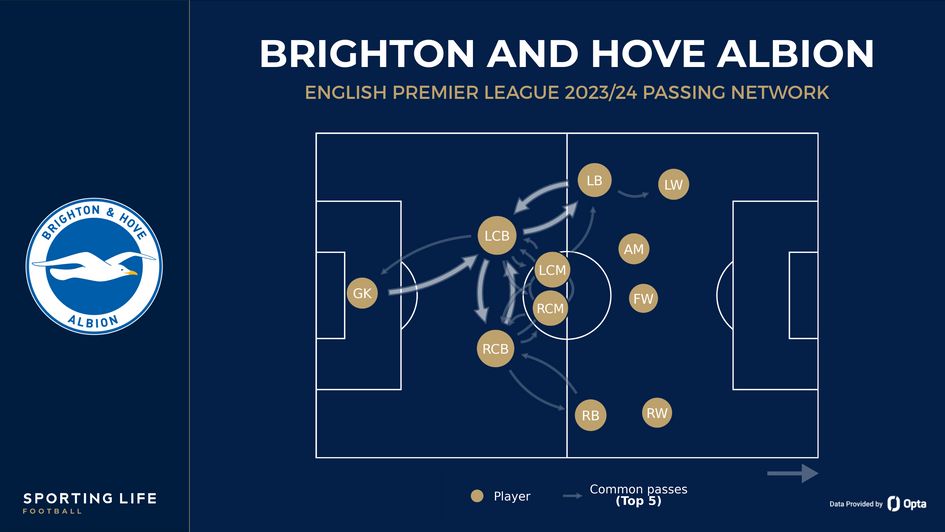
The pace of the attack goes from 0-60 within seconds when space has opened up via a player enticed to win the ball in Brighton’s half.
When a player presses, this is used as a trigger for Brighton’s defenders to release the ball to a midfielder or attacker dropping in, making use of the fact players have committed to the press in the hope they’ll win the ball.
Brighton's skill lies in using the correct timing to wait for players to be sucked into the trap of pressing, then releasing the ball and increasing the speed of the attack, exploiting the spaces opened up.
They dangle a carrot to teams, baiting them into pressing high up the pitch then finding players in the gaps of an opponent’s press.
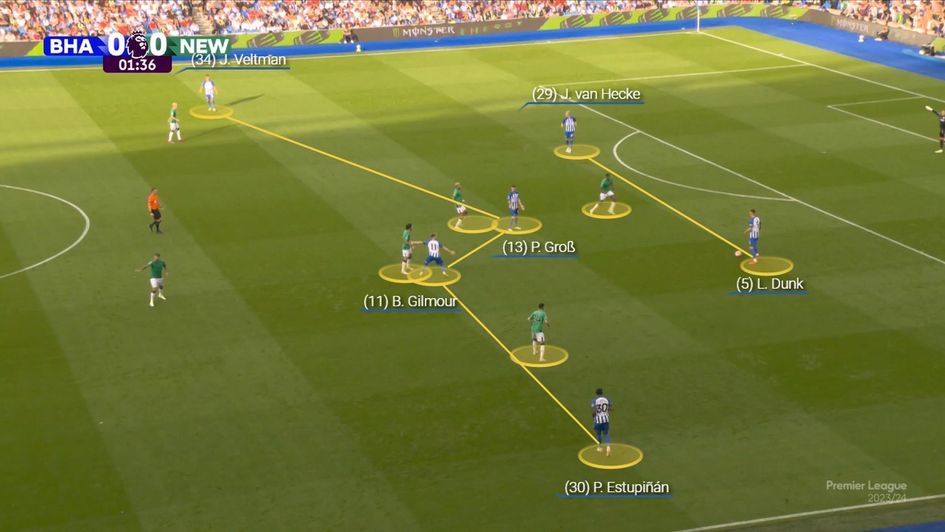
They build up in a 2-4 shape with the two centre-backs deep but able to play out of pressure no matter how close to the keeper they are. Opponents push them back thinking it will deter Brighton from playing out from the back, but they persist regardless.
Fluidity of the system
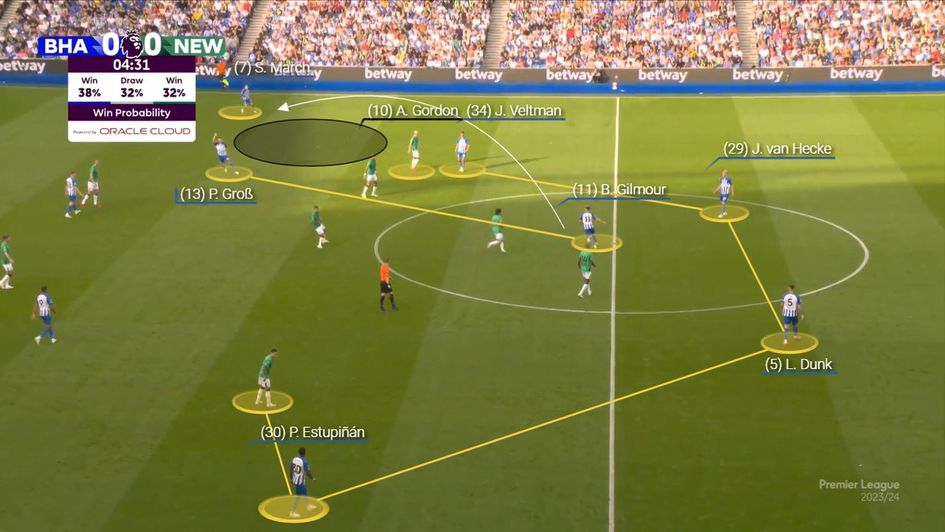
The system is fluid and works so well mainly due to the dangerous movements made by the full-backs.
An example is shown above: Anthony Gordon tracks Joel Veltman who becomes an inverted full-back as Newcastle’s midfield and attack has pushed up to press. Veltman's movements drag Gordon inside, opening up space wide for Solly March.
Joelinton, meanwhile, should be tracking Pascal Gross behind him, but he’s sucked in to Billy Gilmour who has the ball at his feet. This allows Gross, as an advanced midfielder, to push up on the defence, giving Dan Burn an extra player to mark.
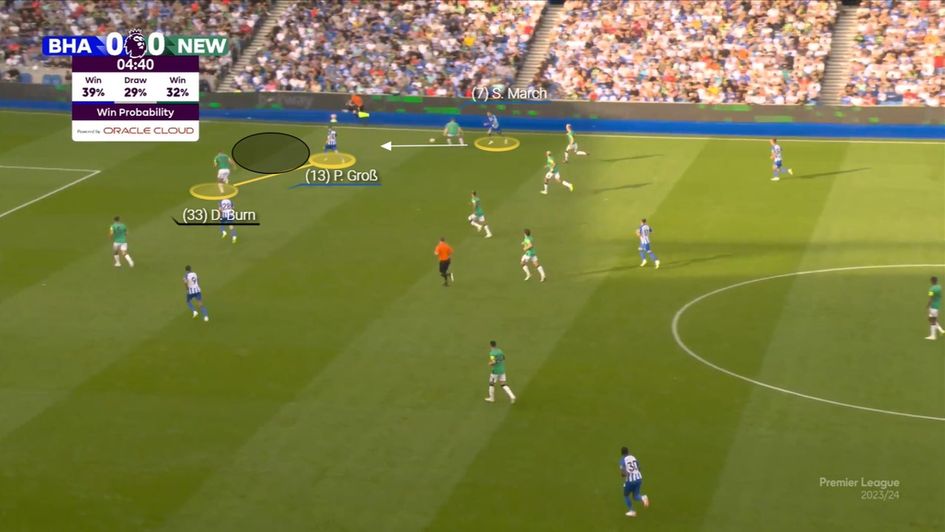
By the time the ball reaches March, Gross is dragging Burn away from the centre-back position as he has to follow him wide.
Similarly, the full-backs for Brighton can provide width or become inverted as depicted above. Pervis Estupinan, in particular, stretches the pitch as much as possible.
When the full-backs are inverted, they’re an extra option in midfield to receive allowing for another midfielder (Gross or Gilmour) to join the attack. When they stay wide, they offer width.
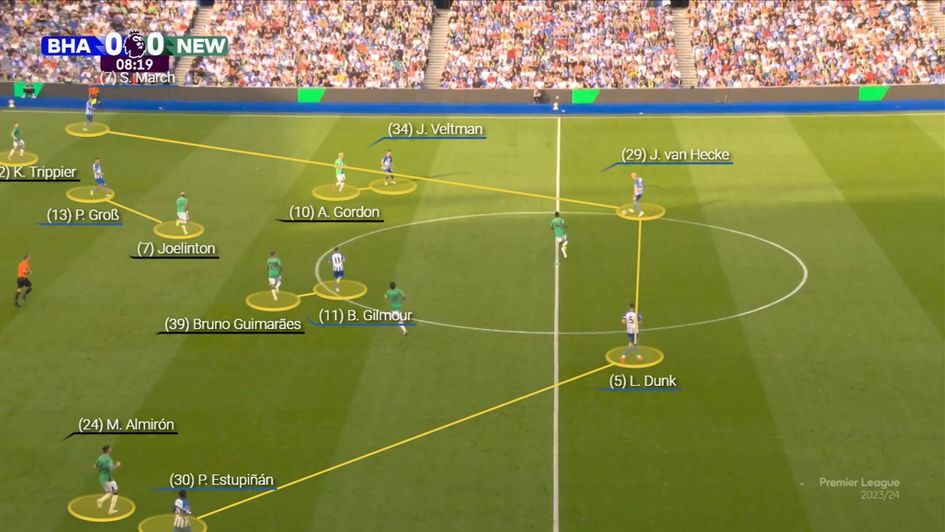
Even when you stick man-to-man on Brighton, their players have learnt to drag the opposing team around.
As Veltman inverts, Gross, just behind, is dragging Joelinton around in the space between Newcastle’s midfield and defence. This spreads the Magpies' block out of possession, increasing the distances and spaces between them.
Alternative routes to progression
Progressing the ball through the middle is where you find space to hurt teams. While you can still cause problems wide, it’s better to be as close to the penalty area in the middle of the pitch.
Progressing centrally for Brighton doesn’t just come from the excellent movement from their full-backs or midfield.
The strikers smartly drop into midfield pockets to receive and play the ball around the corner to another Brighton player, just ahead of the central midfielders.
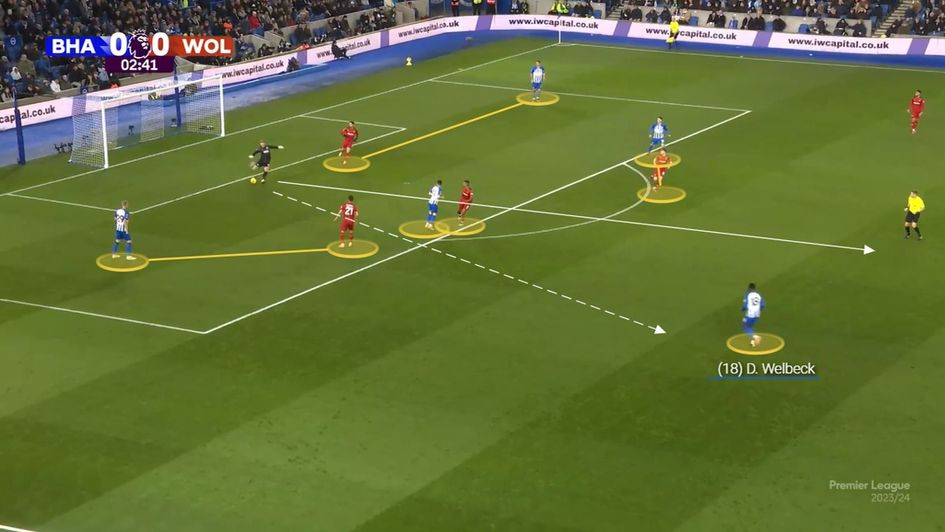
When teams press Brighton’s defence, a striker like Joao Pedro, Evan Ferguson or Danny Welbeck drops deeper, able to collect the ball from the defence.
With Wolves pushing up, Jason Steele opts to bypass their press and pick out an attacker. The attacker drags a defender out of position - and all of a sudden, Brighton are bearing down on goal via a direct ball that has taken out several Wolves players.
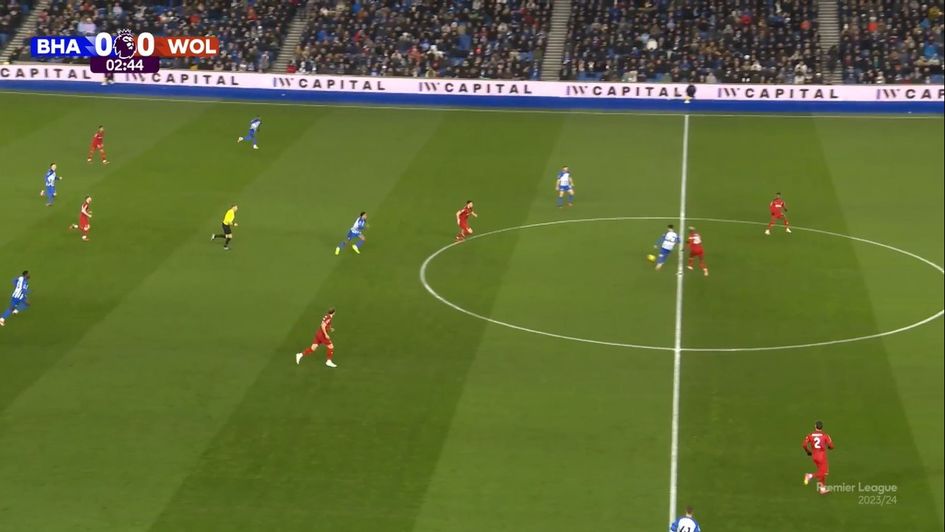
It’s a different way of getting past players that have pushed up to press, the more direct route and Brighton aren’t afraid to do this out wide either, hitting it over the top to play in a winger (Kaoru Mitoma or Facundo Buonanotte) to run at a full-back.
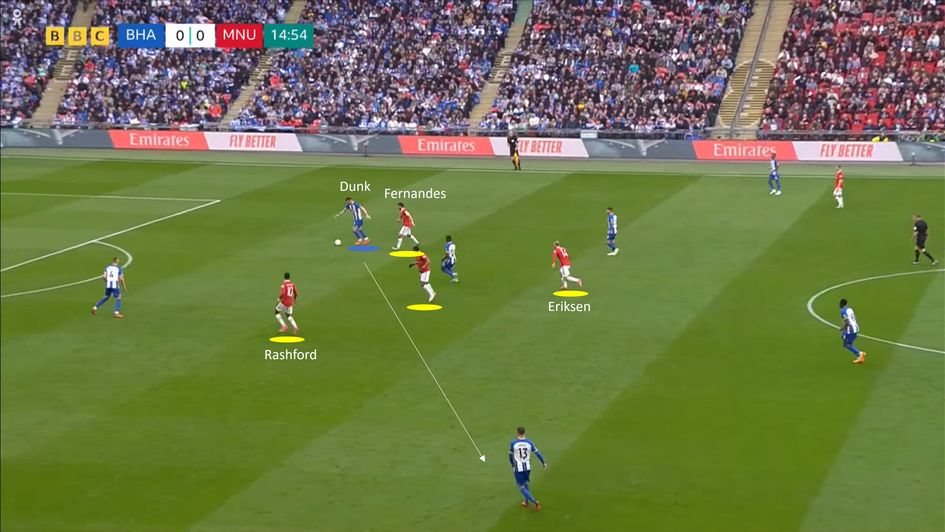
Where are the flaws?
Despite Brighton’s exuberant style of play and their ability to spring into life when teams have fallen into their trap, they are currently on a run of just three wins from 16 in the league.
Premier League teams these days are armed with an army of analysts, eventually they will figure you out.
And that's De Zerbi’s next challenge.
His weakness is unsettling low blocks. He believes in his philosophy more than anything else, exposing Brighton in certain games.
Teams have been sitting off, not pressing and, more importantly, cutting off the central midfield options with the wingers tucked in to make progression difficult and the middle of the pitch as narrow as possible.
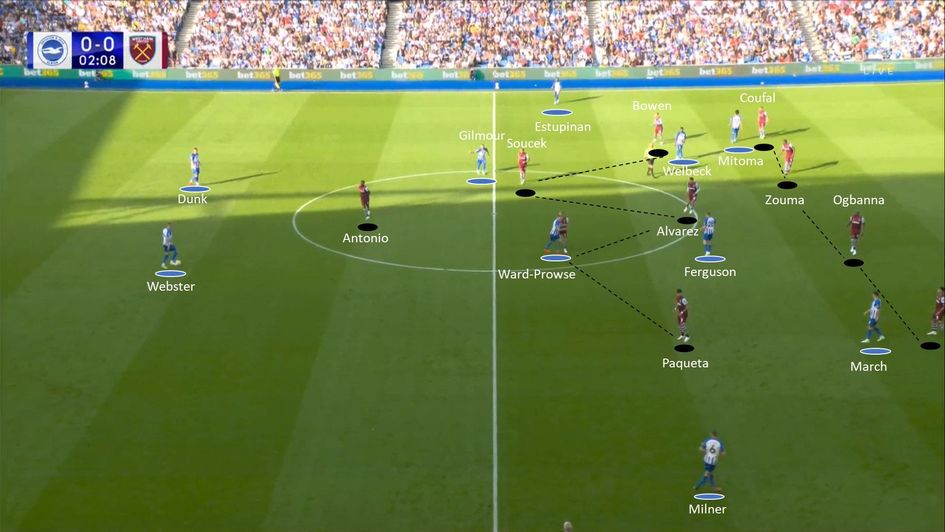
David Moyes' West Ham did this well, shown above.
With James Ward-Prowse and Tomáš Souček marking Brighton’s two midfielders, Lucas Paqueta and Jarrod Bowen squeeze the centre of the pitch from out wide, to stick close to the dropping forward (Welbeck), making the distances small and narrowing the middle.
With Edson Alvarez marking Ferguson, it makes funnelling the ball through the middle of the pitch a lot more difficult, hence Brighton will look to go wide.
If you reduce the space in the centre of the pitch, passing it to Gilmour, Gross, Welbeck or Ferguson becomes tougher. With the wingers in Paqueta and Bowen tucking in too, even if a striker receives the ball, they are always doubled up on.

Narrowing the pitch, clogging it with players while man-marking the full-backs and striker has made it harder for Brighton to find space centrally. Teams have been using this method to thwart them constantly.
When teams have neutralised Brighton’s build-up, they create turnovers to quickly break on the counter as Brighton commit a lot of bodies forward.
It’s not just the fact this weakness has been exposed, it’s that it keeps getting exposed badly.
Losing 6-1 to Aston Villa, 4-0 to Luton. It’s a chink in De Zerbi’s armour and so far, he hasn’t come up with a plan B.
The Seagulls have had to deal with injuries on top of a thin squad and a thinner budget than the teams above them. With constant chop and change, the style of play is hurt by the quality of execution from second-choice players.
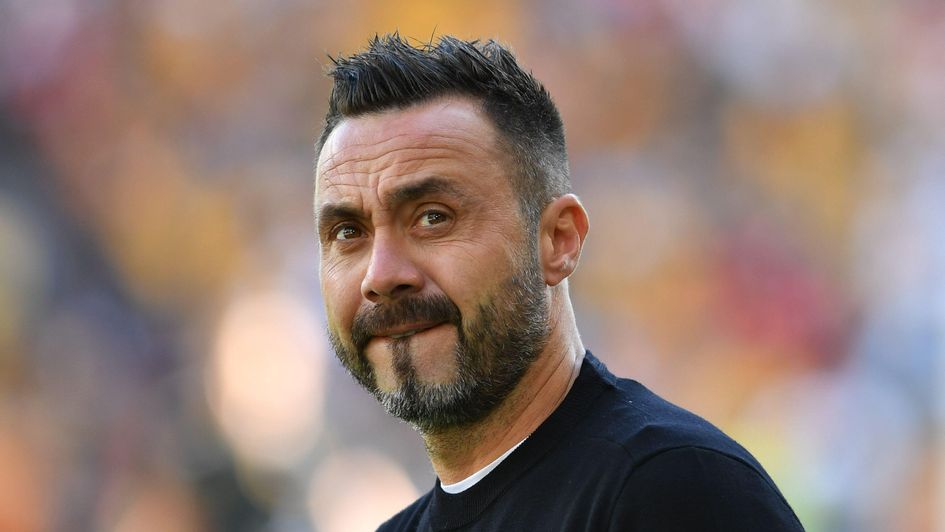
There is the case to be made that if he was to work with better players, improved resources and a bigger budget, De Zerbi would be given more of a chance to solve his low-block conundrum.
He has taken Brighton to Europe, battled losing his best players in the transfer market and, most importantly, built upon the work done by Graham Potter.
There may still be some to do, but his explosive brand of football and feisty temperament may well see him emerge as the best candidate in both Merseyside and Catalonia.
More from Sporting Life
Safer gambling
We are committed in our support of safer gambling. Recommended bets are advised to over-18s and we strongly encourage readers to wager only what they can afford to lose.
If you are concerned about your gambling, please call the National Gambling Helpline / GamCare on 0808 8020 133.
Further support and information can be found at begambleaware.org and gamblingtherapy.org.






